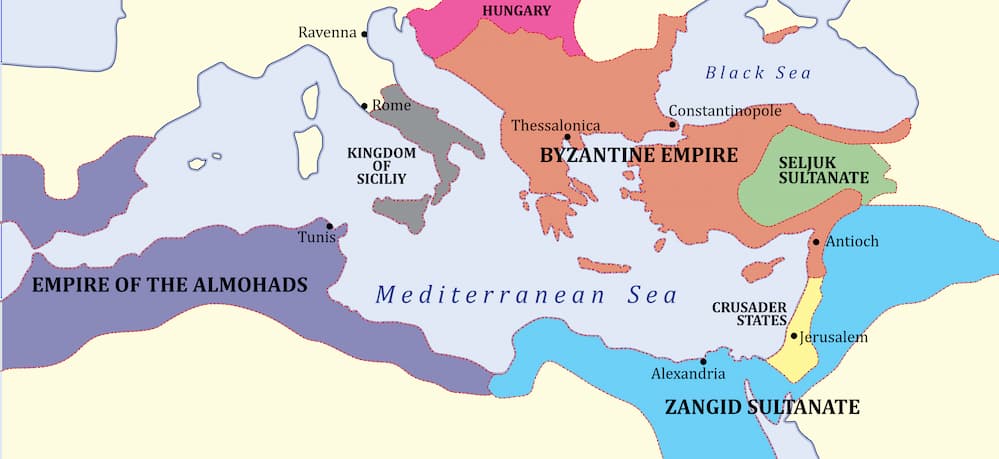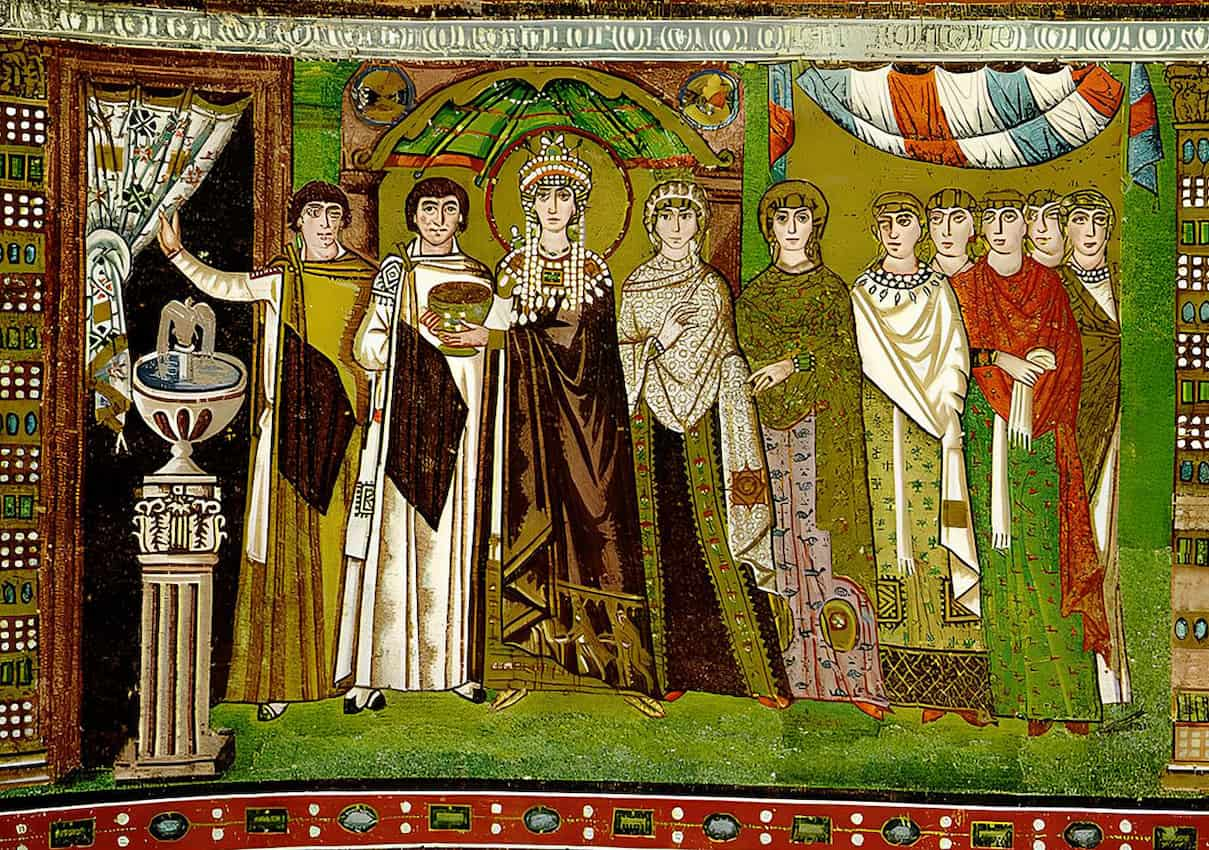Throughout its thousand years of history, various languages were spoken and/or written in the territories of the Eastern Roman Empire (or “Byzantine Empire”). Some languages evolved, others disappeared, many left written records, and all are mentioned in historical sources.
Scholarly Languages in Byzantine
The Empire had two official languages: popular Latin and medieval Greek (Μεσαιωνική Ελληνική). Latin was gradually abandoned by the elites around the 7th century but evolved into Italic Romance languages in Roman Italy and Balkan Romance languages in the lower Danube basin.
Widely understood, medieval Greek became prevalent in the East, where scholars wrote and could also express themselves in Koinè, the Greek language of the Hellenistic period, which has since become literary and scholarly. The Eastern Church initially used liturgical Greek (Ακολουθιακή Ελληνική) and later, in the Balkans, liturgical Slavic, employing the Cyrillic alphabet created for the Slavs by Cyril and Methodius. In Anatolia, the church used liturgical Greek and Armenian, whose alphabet is inspired by both Greek and Aramaic.
However, the diverse populations and various religious denominations in the Empire spoke many other languages, most of which had their own literature and contributed to conveying the tales, legends, knowledge, and debates of their time.
Common Languages in Byzantine
Common Greek
In Constantinople, along the coasts of the Balkan Peninsula and Anatolia, in Calabria, east of Sicily, and across all the islands of the Eastern Mediterranean, common Greek (Μεσαιωνική δημοτική), derived from the Attic Koinè, has always dominated, but with variations: Italic (Κατωιταλιώτικα) in Calabria and Sicily, Hellenic in the Balkans, around the Aegean and the Propontis, Micrasiatic in central and southern Anatolia, Notic in Cyrenaica and Egypt. To these variations, two dialects with Doric traits, also stemming from Koinè, should be added: Pontic around the Black Sea and Tsakonian in the Peloponnese.
Hellenist linguists debate whether the current varieties of modern Greek stem from medieval varieties (which presuppose a continuity of Greek settlement in place, a dominant hypothesis in Greek historiography) or only from Μεσαιωνική δημοτική (“common Greek”) Hellenic (which presupposes a more modern repopulation from Greece, a dominant hypothesis in Turkish historiography).

Demographers emphasize that one does not exclude the other, as under the pressure of military, economic, and environmental events, population movements have not ceased throughout history without the newcomers necessarily eradicating previous settlements (and their dialects). After the gradual settlement of the Turks in Anatolia in the 11th century, a Greco-Turkish dialect, Καππαδοκική Ελληνική / Cappadocian, developed in the Sultanate of Rum, whose name literally means “Sultanate of the land of the Romans,” also known as the “Sultanate of Iconium” and, in Turkey, the “Seljuk Sultanate of Konya.”
Anatolian, Iranian, Thracian, and Illyrian Languages
These are Indo-European languages spoken in the interior of the Balkans and Anatolia. In the Balkans (which were not yet called that; the word “Balkan” meaning “rocky slippery” is Turkish), Thracian and Illyrian languages were spoken, which later evolved either into Albanian dialects (Gheg, Tosk) or, through Romanization, into Vlach dialects north of the Jireček Line and, through Hellenization, into Greek dialects south of it.
In the interior of Anatolia, besides the numerous Greek enclaves in cities, various Indo-European languages such as Phrygian, Thynian, or Bithynian (Thracian languages) and dialects descended from ancient Isaurian and Cappadocian (Indo-European languages claimed by present-day Kurds as proto-Kurdish but linguists classify them in the Anatolian family, not the Iranian family from which Kurdish originates) were spoken. It’s crucial not to confuse Anatolian Cappadocian with the later Greek Cappadocian that emerged after the arrival of the Turks. Sarmatian, Roxolani, and Alan mercenaries in the army also used Iranian languages.
Romance Languages
Byzantine studies, focused on the shift from Latin to Greek as the official language, often overlook the Romance component of the Byzantine Empire. However, in Byzantine Italy, Sicily, North Africa, or the Byzantine part of Hispania, Romance languages were spoken, as well as in the interior of the Balkan Peninsula, where the Romanization of Illyrian and Thracian languages, respectively, produced Dalmatian and Eastern Romance (mentioned by Theophylact Simocatta and Theophanes the Confessor), the origins of Eastern Romance languages. The Byzantine Papacy, in particular, perpetuated the use of not only liturgical but also epistolary and civil classical Latin, also employed by scholars like Cassiodorus.
Later, starting in the 13th century, the colonies of Venetian and Genoese merchants established in Constantinople and other Byzantine ports spoke the corresponding dialects of northern Italy.
The annexation of the Ionian Islands and numerous Aegean islands (including Euboea, Crete, and Cyprus) by the Venetians imposed Venetian Italian as the lingua franca in these islands, leaving numerous place names and expressions in the local Greek language. Finally, the Latin Empire of Constantinople and the Latin states in the East established by the Crusaders in Greece promoted the use of medieval French and, in central Greece, Catalan in the armies and Latin colonies.
In popular Greek, the Latins are also indiscriminately called Franks (Φράγκοι): a designation more religious than linguistic.
Slavic and Turkic Languages

From the 6th century onwards, Slavic languages (such as Sorbian, which contributed to the emergence of Serbo-Croatian, and Slavic) were added to the indigenous languages of the Balkans, as well as the Iranian-Turkic languages of the early Bulgars (a nomadic people from the Pontic steppe adhering to Tengriism, who adopted Slavic and Christianity) and the Gök-Oğuz (claimed by the present-day Gagauzes). In Anatolia, starting in the 11th century, the Turks began to settle, Turkify, and Islamize their inhabitants; initially, they wrote their languages in the Greek alphabet.
Additionally, many mercenaries of the Empire, including Antes or Khazars, were speakers of Slavic or Turkic languages.
Armenian and Caucasian Languages
In eastern Anatolia, from Cilicia to the Black Sea (which was not yet called that; this name is from Turkish, and the sea was then called the “Pontus Euxinus”), Armenian (another Indo-European language) and Laz, similar to modern Georgian, dominated. Literary and liturgical Armenian was also present elsewhere in the Empire, where Armenian communities lived.
Languages of East and North Africa
The Southeast (Syria, Canaan, and the extreme Northwest of Arabia) of the Byzantine Empire was the domain of various Aramaic dialects, including Syriac from Edessa (the language of communication and liturgy for the Semitic Christians of the region), Mandaic dialects, and various versions of Neo-Aramaic. In cities, these dialects coexisted with medieval Greek. In Egypt, the vernacular language was Coptic, derived from ancient Egyptian.
From the 8th century, after the intense Perso-Byzantine and Arabo-Byzantine wars, the long-standing Greek influence in the southeast of the Empire (for a millennium, in some places) and Latin influence in North Africa (for over six centuries) were erased. The Semitic populations (Syrians, Canaanites, Nabateans, etc.) and North Africans in the broad sense (the Egyptians and those commonly referred to today as Berbers) underwent linguistic and cultural Arabization and gradually became minorities among the Islamized Arabic speakers.
In contrast, Hellenistic Judaism persisted for another thousand years through the “Byzantine Jews,” who spoke Yevanic, following the Jerusalem Talmud, and whose synagogues continued to use Hebrew in the liturgical context. They were gradually assimilated first by the Arab Jews of the East and later by the Sephardim from the Iberian Peninsula, transitioning to the Babylonian Talmud, Ladino liturgy, and Judeo-Spanish language. A minority eventually became Turkish-speaking and Muslim, and a few Greek Jews remain in the 21st century after the majority of the community was annihilated during the Holocaust.
Other Languages
From the 10th century, Varangian mercenaries, of Scandinavian Germanic origin, also served in the Byzantine forces; it is likely that one of them engraved the runes visible on the current Byzantine lion at the entrance of the Arsenal of Venice. Finally, some law enforcement forces with multiethnic recruitment, such as the Vardariots or Vardariotai (Βαρδαριῶται), may have spoken Iranian, Finno-Ugric, or Turkic languages.


